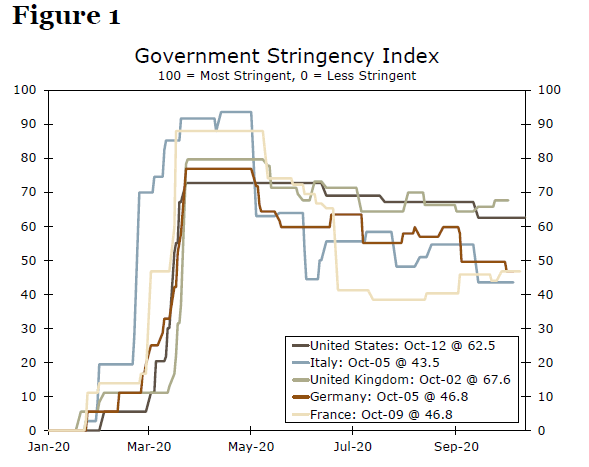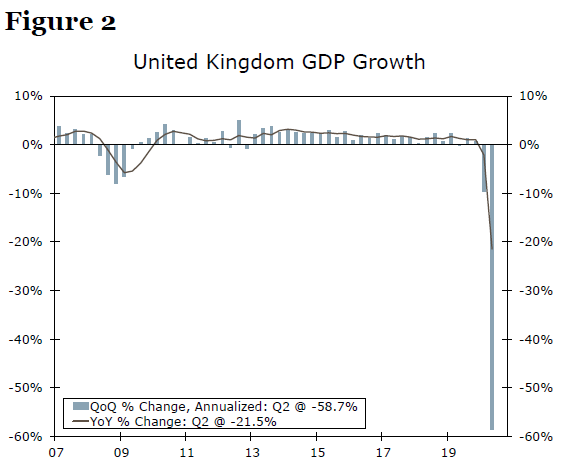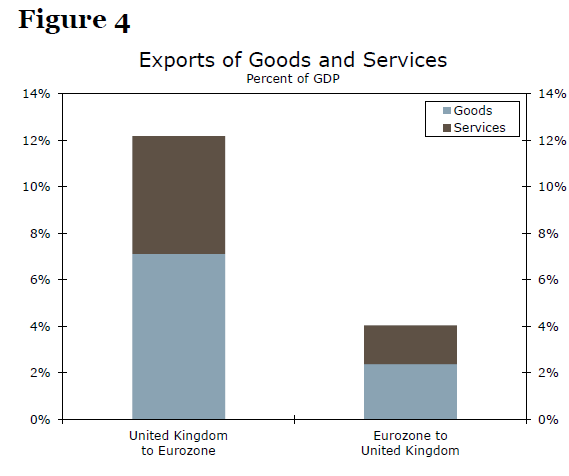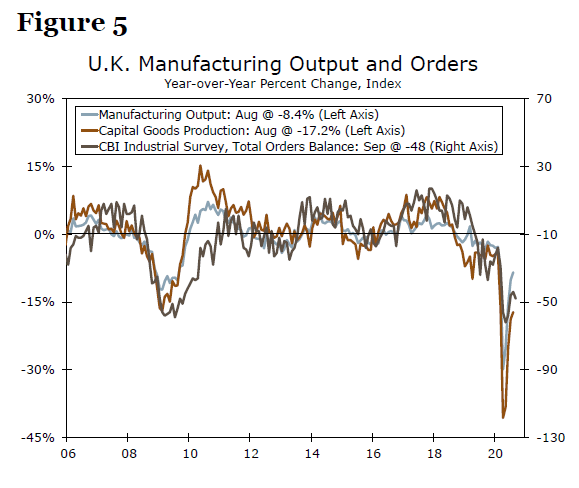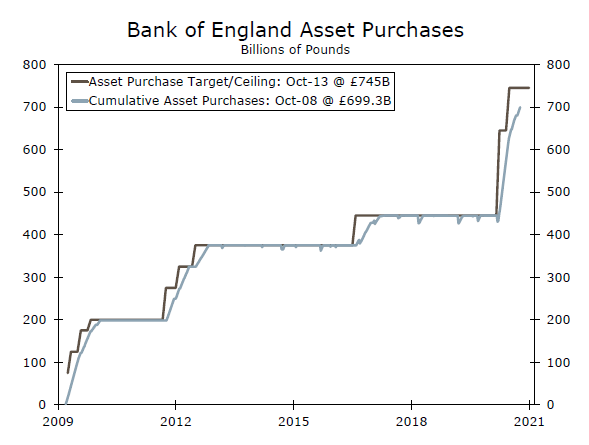Executive Summary
- Seemingly never ending uncertainty related to Brexit and a gut-wrenching battle against COVID-19 has wreaked havoc on the U.K. economy.
- Like most other economies, the U.K. economy began to bounce back in late spring/early summer. But, the recent rebound is threatened by a second wave of COVID-19 cases.
- More fiscal stimulus would help keep economic momentum going. Although, there are signs that the U.K. government is softening its position on winding down much of the economic support enacted in the spring. In our view fiscal policy is, at best, likely to exert a neutral impulse to economic growth going forward.
- A trade deal with the European Union by December 31 would eventually help, and it remains our base case outcome.
- Even so, the challenges facing the British economy are severe, and we expect the central bank will respond with a further £100B increase in its asset purchase target to £845B at its early November meeting.
- Given the less-than-compelling outlook for the U.K. economy and the likelihood of further monetary easing, we expect the pound to remain a laggard among the G10 currencies.
U.K. Economy Faces Potentially Grim Winter
The United Kingdom’s economy entered 2020 on somewhat shaky footing. Real GDP growth was just 1% year-over-year in Q4-2019 as Brexit uncertainty and a mildly sluggish global growth environment weighed on the British economy. Then, when COVID-19 struck, the United Kingdom was relatively slow to lock down. The University of Oxford’s government stringency index, which measures how strictly governments are restricting private activity, spiked a week or two later than many other developed market countries (Figure 1). Subsequently, the United Kingdom was much slower to ease restrictions, and for most of the summer through today the United Kingdom’s stringency index reading has been higher than many of its peers.
The fiscal policy measures taken by U.K. policymakers to support the economy in response to the pandemic were robust by absolute standards, but relatively modest compared to other developed market economies. The lynchpin of the U.K. fiscal relief effort, the Coronavirus Jobs Retention Scheme (CJRS), has subsidized private sector labor costs such that the unemployment rate in the United Kingdom was 4.5% for the three months to August, only moderately higher than the 3.9% reading for the three months to January. Still, government support has not been enough to keep household incomes completely whole. Household disposable income in the United Kingdom was down 3% quarter-over-quarter in Q2-2020, better than the Eurozone (-3.3% quarter-over-quarter), but much worse than the United States (+9.6% quarter-over-quarter) and Canada (+10.8% quarterover- quarter).
Against this backdrop, the U.K. public health and economic outcomes have been less than ideal. Deaths per million from COVID-19 in the U.K. are a bit higher than Italy but slightly lower than Spain, two of the hardest-hit countries in the world. Similarly, U.K. real GDP was down 21.5% year-over-year in Q2 (Figure 2), worse than the Eurozone region (-14.7% year-over-year) as well as the United States (-9% year-over-year), and broadly on par with Italy (-18% year-over-year) and Spain (-21.5% year-over-year).
Like most other economies, the United Kingdom began to bounce back in late spring/early summer. But, the recent rebound is threatened by a second wave of COVID-19 cases. New cases of COVID-19 have been on the rise since the end of summer, and in recent weeks total cases have accelerated (Figure 3). In response, government officials have re-imposed some restrictions, with bars and restaurants now closing at 10pm and gatherings of more than six people banned other than for certain events such as weddings (maximum 15 people) and funerals (30 people). 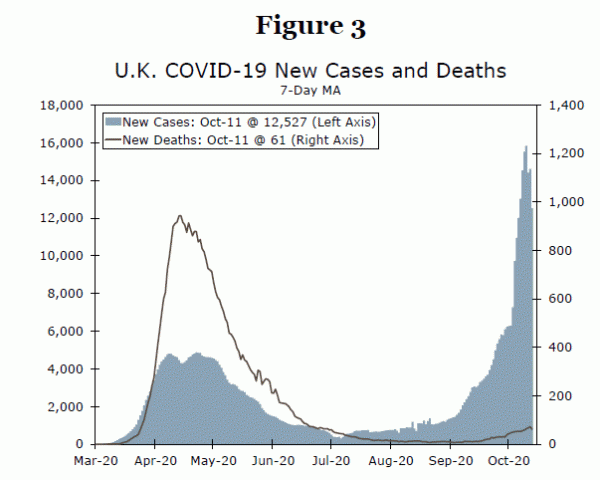
Recently, monthly GDP data showed some signs of a slowing recovery. August real GDP grew 2.1% month-over-month, below the consensus forecast and much less than the 6.4% gain in July and 9.1% gain in June. Compared to August 2019, the U.K. economy was 9.3% smaller. By sector, services output grew a moderate 2.4% month-over-month in August, while industrial output rose a meager 0.3% month-over-month. Given the acceleration in cases that began at the end of summer, as well as the tightening of government restrictions that have accompanied this spike in cases, the near-term outlook for U.K. GDP appears worrisome.
How Can Policymakers Respond?
The challenges and downside risks facing the U.K. economy amid a wobbly recovery and soaring COVID-19 cases are fairly straightforward. What then can be done to build momentum for a further economic rebound? For starters, the U.K. government could embark upon another sizable salvo of fiscal stimulus. Already, there have been some additional fiscal measures adopted recently. Starting on September 28, for example, people on lower incomes who are told to self-isolate through the Test & Trace system will receive a £500 payment.
Despite such moves, these new fiscal policy measures at best seem likely to have a neutral impact on the economy going forward. In its last monetary policy announcement and minutes, the Bank of England (BoE) noted that, despite progress in getting furloughed workers back to work, as of the second half of August, the share of private sector employees who were furloughed still appeared to be about 16%.
The CJRS was set to expire at the end of October, putting these furloughed workers at risk. The original U.K. government plan was to institute a new program that would have seen the government roughly splitting the cost of an employee’s wages with participating firms, with the idea being that support would be less generous and more targeted in an effort to support “viable” jobs. Last Friday, the U.K. government reversed course and announced that it would make these terms more generous for some firms that would now only need to cover tax contributions for employees that are not working, equating to about 5% of wages. That said, the terms of the program still appear to be less generous than the CJRS. For example, workers will see overall pay drop to 66% of normal pay, down from 77%.
A rise in unemployment during Q4-2020 as some workers are displaced and wage subsidies are reduced, could further weigh on household income growth, reining in the recovery. That is a notable contrast to the United States for example, which has already seen robust household income growth and is currently debating another round of fiscal stimulus that could be even bigger than the support enacted in the spring.
With yields on U.K. sovereign debt even lower than they are in the United States, the U.K. government could arguably be more forceful in implementing further fiscal stimulus in light of the deteriorating COVID situation. In our view, we believe this would help create a more constructive economic outlook for the United Kingdom over the next few quarters. However, the likelihood of significant further fiscal measures does not appear probable at the current juncture. As a result, it may fall on monetary policymakers to provide further support for the economy—a topic to which we will return later.
Brexit Brinkmanship Batters Business Investment
Another important influence on the U.K. economic outlook is the ongoing discussions between the United Kingdom and the European Union on the parameters of a post-Brexit trade deal. Publically at least, there seems to have been limited progress in the talks so far. In recent days, the European Union has said it would ignore a mid-October negotiating deadline, anticipating a back-down from the U.K. In contrast, the U.K. said it would quit Brexit talks if no deal is seen by October 15.
Given the fluid and constantly evolving nature of Brexit discussions, our goal here is not to provide a detailed range of potential Brexit scenarios. Rather, our underlying assumption remains that a trade-deal between to the two sides will be reached by December 31. That could be an eleventh hour agreement as has often occurred in the past (which would imply a resolution well past mid-October), or conceivably there could be an earlier breakthrough. In the interim, the main areas of contention between the United Kingdom and European Union have been:
- The precise nature of a trading relationship following the end of the Brexit transition period.
- Irish border issues, including the treatment of an “internal border” for shipments between Northern Ireland and the rest of the United Kingdom.
- European access to U.K. fisheries.
- Rules relating to state aid for companies.
One reason we believe a deal will ultimately be struck between the U.K. and E.U. is that any significant disruptions to trade would have significant implications for the broader economy of the two regions. For 2018—the latest year for which comprehensive data are available—U.K. exports of goods and services to the Eurozone accounted for 12% of overall U.K. GDP. In reverse, Eurozone exports of goods and services to the U.K. accounted for 4% of overall Eurozone GDP. Any substantial disruptions to trade at the current juncture would be especially unwelcome, particularly against the backdrop of a COVID-induced downturn
An eventual trade-deal should be beneficial for the U.K. economic outlook over time. That said, the “will they or won’t they” nature of the Brexit negotiations, as well as the unknowns about the exact specifics of any trade deal, have contributed to near-term uncertainty and could keep business investment in check. This is evident in the incoming manufacturing data. In the latest available data, August manufacturing output was still 8.4% below year-ago levels and, acknowledging it is a somewhat more volatile series, the production of capital goods was 17.2% below year-ago levels. Meanwhile at -48 in September, the orders balance from the Confederation of British Industry trends survey remains near the lows seen during the current cycle and the global financial crisis during 2008-09.
Expect Another Dose of Monetary Policy Medicine
Given the sluggish start to the U.K. economic rebound, a restrained outlook for the U.K. consumer and an underwhelming outlook for U.K. businesses, we expect the BoE will deliver more monetary easing soon. Market speculation has centered on whether any further easing might include a shift in U.K. policy interest rates into negative territory, a further expansion in asset purchases, or a combination of the two. Speculation regarding the possibility of negative interest rates intensified after the minutes of the BoE’s September monetary policy meeting indicated the central bank would start engaging with U.K. banking regulators about preparations needed for a move to a negative interest rate environment. Subsequently, however, central bank governor Bailey downplayed the likelihood of such a move, saying the BoE had not reached any judgement on whether to introduce negative interest rates, and that other tools were available if necessary.
Instead, we expect Bank of England monetary easing to take the form of a further increase in asset purchases, especially with cumulative asset purchases (currently around £699B) quickly closing in on the overall asset purchase target of £745B. Accordingly, to help sustain the recovery, our view remains that the central bank will announce a further £100B increase to its asset purchase target to £845B at its early November meeting. We believe that is an outcome that is substantially—but not yet fully—priced into markets, and as a result we think that further monetary easing could be a restraining factor for the British pound. Given the less-than-compelling outlook for the U.K. economy and the likelihood of further monetary easing, we expect the pound to remain a laggard among the G10 currencies.




